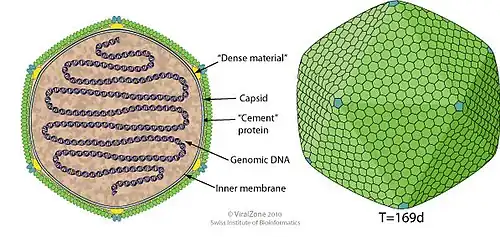Raphidovirus
| Raphidovirus | |
|---|---|
| Virus classification | |
| (unranked): | Virus |
| Realm: | Varidnaviria |
| Kingdom: | Bamfordvirae |
| Phylum: | Nucleocytoviricota |
| Class: | Megaviricetes |
| Order: | Algavirales |
| Family: | Phycodnaviridae |
| Genus: | Raphidovirus |
Raphidovirus (likely misspelled Rhaphidovirus) is a genus of viruses, in the family Phycodnaviridae. Alga serve as natural hosts. There is only one species in this genus: Heterosigma akashiwo virus 01 (HaV01, Raphidovirus japonicum).[1][2][3]
Structure

Viruses in Raphidovirus are enveloped, with icosahedral and round geometries, and T=169 symmetry. The diameter is around 100-220 nm. Genomes are linear, around 295kb in length.[1]
| Genus | Structure | Symmetry | Capsid | Genomic arrangement | Genomic segmentation |
|---|---|---|---|---|---|
| Raphidovirus | Icosahedral | T=169 | Enveloped | Linear | Monopartite |
Life cycle
Viral replication is nucleo-cytoplasmic. Replication follows the DNA strand displacement model. DNA-templated transcription is the method of transcription. The virus exits the host cell by lysis via lytic phospholipids. Alga serve as the natural host. Transmission routes are passive diffusion.[1]
| Genus | Host details | Tissue tropism | Entry details | Release details | Replication site | Assembly site | Transmission |
|---|---|---|---|---|---|---|---|
| Raphidovirus | Alga | None | Cell receptor endocytosis | Lysis | Nucleus | Cytoplasm | Passive diffusion |
References
- ^ a b c "Viral Zone". ExPASy. Retrieved 15 June 2015.
- ^ "Virus Taxonomy: 2024 Release". International Committee on Taxonomy of Viruses. Retrieved 23 March 2025.
- ^ "History of the taxon: Species: Raphidovirus japonicum (2024 Release, MSL #40)". International Committee on Taxonomy of Viruses. Retrieved 23 March 2025.